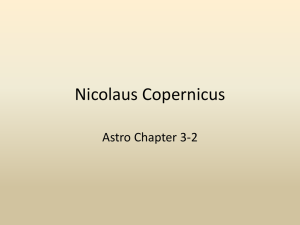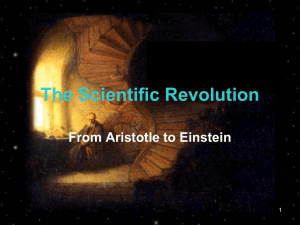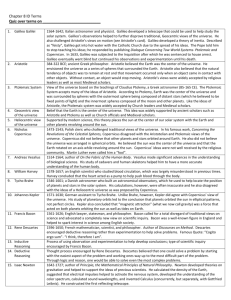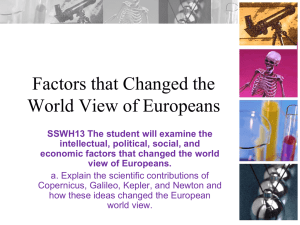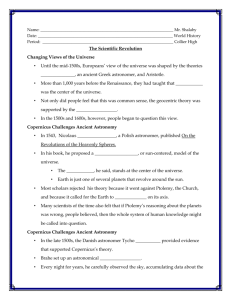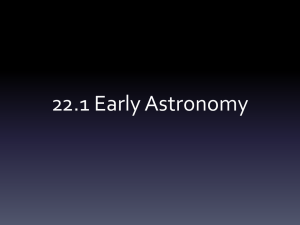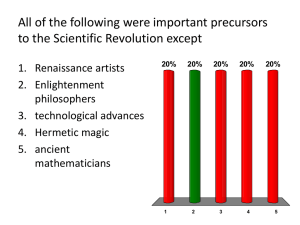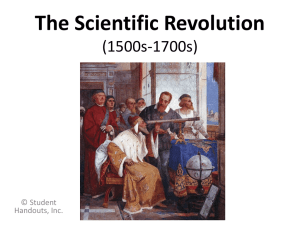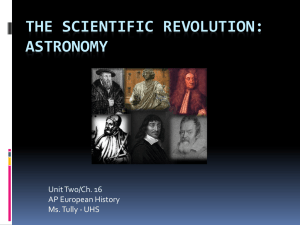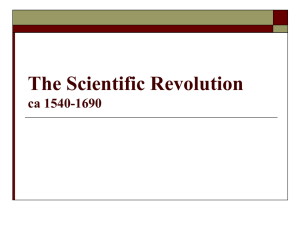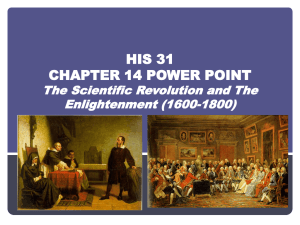Scientific Revolution 16th-17th Centuries
advertisement
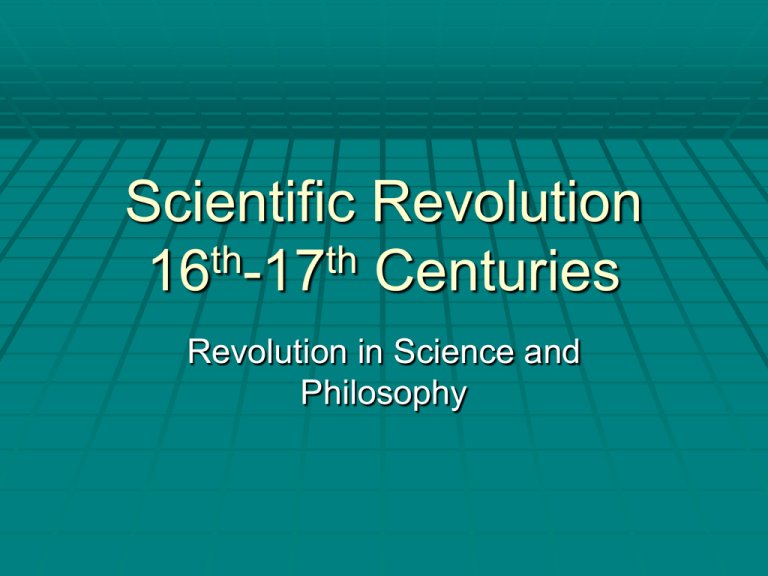
Scientific Revolution th th 16 -17 Centuries Revolution in Science and Philosophy Ancients on whom Medieval Renaissance Science was Based Aristotle Astronomy: Geocentric Crystal spheres All circular (perfect) Physics Body in motion as long as whatever moves it in contact with it Straight line motion on earth; circular motion in heaven Chemistry 4 elements: earth/water/fire/air 5th essence perfect, indestructible, never changing Galen Background Roman physician 200 AD Used Aristotle’s theories in anatomy and medicine Three books on human anatomy from observation Physician to gladiators and cut up and experimented on apes (lead to mistakes) Circulation wrong: blood from one chamber of the heart to another seeped through invisible pores in the dividing walls; venous and arterial systems closed, do not cross Medical theories (based on Aristotle; 300-600 AD) 4 elements in people: blood, phlegm, black bile, yellow bile disease=imbalance in elements; out of balance =dominant humor determines personality Choleric (ego/blood), sanguine (nervous system/astral body), phlegmatic (etheric or life body), and melancholic (physical body). The ancient doctrine of the Four Humors, as illustrated in this medieval manuscript was to tie them to four basic temperaments (above, clockwise): phlegmatic, sanguine melancholic and choleric. Burton's Anatomy of Melancholy(1) published in 1621: “Blood, a hot, sweet, tempered, red humour, prepared in the meseraic veins, and made of the most temperate parts of the chylus (chyle) in the liver, whose office it is to nourish the whole body, to give it strength and colour, being dispersed through every part of it. And from it spirits are first begotten in the heart, which afterwards in the arteries are communicated to the other parts. "Pituita, or phlegm is a cold and moist humour, begtotten of the colder parts of the chylus (or white juice coming out of the meat digested in the stomach) in the liver. His office is to nourish and moisten the members of the body. "Choler is hot and dry, begotten of the hotter parts of the chylus, and gathered to the gall. It helps the natural heat and senses. "Melancholy, cold and dry, thick, black and sour, begotten of the more feculent part of nourishment, and purged from the spleen, is a bridle to the other two humours, blood and choler, preserving them in the blood, and nourishing the bones. "An exact balance of the four primary humours makes the justly constituted man, and allows for the undisturbed production of the concoctions or processes of digestion and assimilation.” Medieval “Science” Two bases fore knowledge: Bible and the ancients (Aristotle, Galen, etc.) Science follows scriptures, especially Old Testament (5th-16th Centuries) Scholasticism linked classical thinkers (Aristotle) to Christian faith Ptolemaic Universe Ptolemy observed the planets and concluded from his observations Base of his science = Aristotle, still Problem of retrograde movement Because the earth moves around the sun, planets’ observed motion goes backward in relation to earth, not parallel with earth Ptolemy explained seemingly backward movement by epicycles (circles on top of circles) Epicycles Development of Scientific Method Francis Bacon (1561-1626) “godfather of science” Background courtier, Chancellor of England Court intrigues—convicted on charges of corruption NOT a scientist (failed to add math to the mix) Provided reasoning, theoretical basis for science Inductive method—particular to general science=cause/effect explanations Observation and experimentation gives data; on basis of data, conclusions=knowledge Empiricism –the consequent knowledge based on observation and experience Bacon‘s works New Atlantis Truth = useful knowledge; truth should be applicable to reality, not just theory Utopia = when through knowledge, command nature to create a perfect society Nouvum organum New way to knowledge useful to mankind Descartes 1596-1650 French philosopher, mathematician Rational structure of world; confidence in math to describe that structure Contributions Deductive Method defined General truths , reason from them to apply to specific cases General truths come from assumptions about matter, axioms, other deductions, geometric like truths “I think, therefore I am” Not truth from tradition and scriptures, but from own intellect Not from senses: deceiving; from thought Cartesian dualism God created two essential realities: spiritual and physical Everything in the physical realm = mechanical; principles of being applied inevitably; one needs to reason to discover them Works Discourse on Method Advances in Math Descartes Cartesian graphing and coordinates Analytical geometry Napier (Scot) 1614 invented logarithms Newton/Leibniz invented calculus Huyghens (Dutch) Calculated the force necessary to keep a planet in orbit Advances in Biology and Chemistry Vesalius (Flemish) 1543 On the Fabric of the Human Body challenged Galen. ie blood flowing from one chamber to another in heart Harvey (British: 1578-1657) demonstrated that the heart was a pump Showed that blood circulated through the body Leewenhoek (Dutch- Used the new microscope to see blood corpuscles, sperm, bacteria Published drawings; noone took bacteria seriously as cause of disease, though More (advancements in chemistry) Boyle (1627) Law on pressure of gasses God’s choices in creating the universe were unrestrained= unexplainable choices Can experiment and experience to discover those choices, apply Later, experiences on atmosphere lead him to belief in mechanistic universe (explainable by laws) Lavoisier(1743-1794) Father of modern chemistry Law of conservation of matter—cannot be created or destroyed Advancements in Physics Galileo (1564-1642) Law of Inertia Objects travel in line until moved upon by outside force Famous experiment about falling objects Bodies falling to the ground hit at the same time with allowance for air resistance (size determines) = 32 mile/second/second Advances in Astronomy New view of the world New view of the heavens New view of man March toward secularization of society All made possible by invention of the telescope in 1608: No one knows who invented: 3 rival claimants in the Netherlands; refracting lenses to make light bend Newton 1668: reflecting telescope with mirror gives sharper image Copernicus 1473-1543 Background: b. Prussia (now Poland) Educated to be church official Studied classics, math, law, medicine + Doctorate of canon law U. of Ferrarra—canon of cathedral Back to Prussia to be uncle’s physician/secretary/legal advisor Developed the idea of the heliocentric universe Bothered by Ptolemaic epicycles “On the Revolutions of the Heavenly Spheres” Published just before his death because he knew what would happen Resistance Placed on index of prohibited books Calvin– “who will venture to place the authority of Copernicus above that of the Holy Spirit?” Biblical: Psalm 93 (“Thou hast fixed the earth, immovable and firm….”) and Joshua (commands sun, not earth, to stand still) Tycho Brahe (1546-1601) Danish Brahe nightly observed and records the path of the planets for 20 years Concluded Ptolemaic epicycles incorrect Believed planets revolved around the sun; sun and moon revolved around the earth Gave records to friend/student Kepler Noted for Precise measurements of planetary positions Reconsideration of Copernicus circular orbits Brahe’s Universe Johannes Kepler (1571-1630) German Geometric universe Used Brahe calculations to prove elliptical orbits with sun as focus Three Laws of Planetary Motion Planets orbit in elliptical motion Speed of a planet slows in proportion to distance from the sun (not same rate of speed all the way through its orbit) Square of time taken by any 2 planets in revolutions around the sun is in the same ratio as the cube of their average distances from the sun Galileo Galilei (1564-1642) Background Italian son of musician and noble wife; monastic school and U. of Pisa: medicine, math, and natural science— prof of math Arrogant/sarcastic/argumenttive Founder of modern experimental science Patrons=Medicis Friend of Pope Urban VIII; supported by Jesuits; attacked by Dominicans Improves telescope and makes discoveries Moon—not perfect surface, but craters and mountains Stars: bright stars closer to earth than dim stars; 500 new stars; Milky way=stars Supports heliocentric theory of Copernicus Jupiter 4 moons, not encased in crystal orb (evidence for Copernican theories— trouble with the Inquisition because no longer 7 major heavenly orbs –sun, moon, 5 planets; 7 mystic number) Demonstrated newly visible bright star (supernova) outside system of planets— NOT Aristotelian view of spheres; change in the heavens Published “Dialogue on Two Chief Systems of the World” about his discoveries, proof of Copernicus heliocentrism Published privately--Copernicus system probably correct, Cadinal Bellarmini (becomes Pope Urban VIII) warned him not to hold Copernican theory as reality Refuses to back down; puts pope’s view (one half of dialogue) in mouth of “Simplicio,” Simpleton Consequences Placed on interdicted list; brought before Inquisition and tried for heresy; threatened with rack and strappado Under this pressure, signs recantation; supposedly, as he is leaving, under his breath, “But it still moves.” (the earth) House arrest for the remainder of his life: “I who enlarged the universe 100,000 times have now shrunk to the space of my own body” “God is the author of two great books—the book of scripture and the book of nature. These cannot be in conflict; so any apparent contradictions come from fallible human interpretations…Scripture is a book about how to go to heaven; not a book about how heaven goes.” “I do not feel obliged to believe that the same God who has endowed us with sense, reason, and intellect has intended us to forgo their use.” - Galileo Galilei Sir Isaac Newton (1642-1727) Background: England Father died before born; premature Cambridge U studied classical math Plague closed U; home and wrote basis of most work (ages 22-24) Mathematician first Binomial theorem Differential calculus Controversy: Liebniz claimed HE invented it. Physics Nature of light: experimented with prism and light: white light = all colors, only refracted, bent by prism/atmosphere Gravity (Galileo—all moves in straight line unless force applied; had to explain why planets do not fly off in straight line) Laws of Motion Pendulums Astronomy Heaven and earth in one grand system with gravity and other laws operating Published Principia Mathematica (Math. Principles of Natural Philosophy) Because understand gravity, man can use reason to understand and predict tides Aided in navigation, cartography, artillery trajectory Universe operates on “natural law”; immutable, inviolable, discoverable through reason Extensive religious writings “If I have seen further, it is by standing on the shoulders of giants” But arrogant enough to fly into a rage when criticized Used position in Royal Society to “investigate” controversy over who invented calculus. Pope: “Nature and nature’s laws lay hid in night./God said, ‘Let Newton be,’ and all was light.” Progress of this revolution in thought Merging science and technology Technology previously independent of science Use of mathematics Use of experimentation and inductive reasoning Science separated from philosophy Basic ancient truths were questioned Focus on physics, not ethics and metaphysics History viewed as progressive Impact of Scientific Revolution Natural Law Maintains order in the universe Rules the universe Laws absolute Man, through reasoning and intellect, can discover these laws Rise of Skepticism Man (Earth) no longer center of universe Gap between Christianity and science In world operating on fixed laws of nature, what role left for God in world? Mechanical view of Universe With belief that true knowledge in a particular area is uncertain + church view of universe proven wrong—doubt of religion "The rise of the scientific spirit was a notable feature of the Renaissance [and, especially, just afterwards]: men no longer accepted without question the opinions of the ancients about the universe and the laws governing the natural world; dogma was subjected to experiment, and when it failed to survive the test it was rejected and new theories were formulated. Thus science in the modern sense was born, and rapid progress was made in mathematics, physics, chemistry, and biology. But the immediate consequences for technology were confined to a few specialized fields; in the main, technological progress still depended upon the use of empirical methods by practical men. On the whole, up to 1750 science probably gained more from technology than vice versa." – T.K. Derry and T. I. Williams, A Short History of Technology Montaigne (1553-1592) French essayist Best known skeptic “What do I know? Nothing.” How do you know what you know, and how do you know you know it? New sense of Evidence Heresay and rumor no longer considered fact in law courts (1650) Decline in prosecutions for witchcraft Opens doors for 18th Century deism: belief in God (“first cause” of universe), but not a god that interferes with human affairs; no miracles, just other natural laws Overview: Scientist Copernicus Galileo Bacon Descartes Newton Lavoisier Contributions Challenged a basic theory Linked experiments and math Scientific Method Theoretical Science Applied laws to the universe Quantification of experiments
